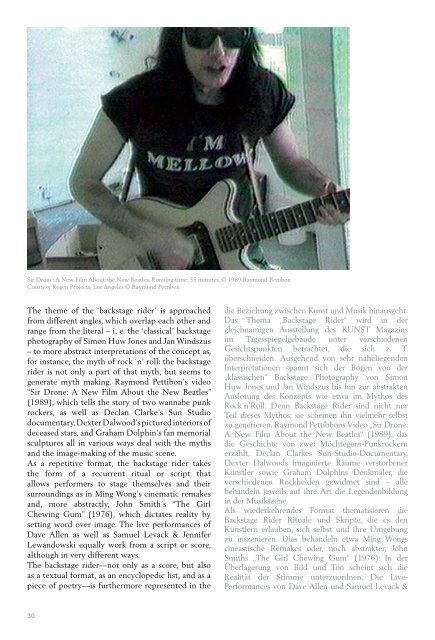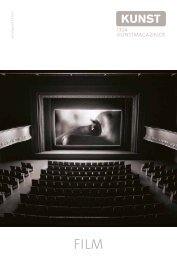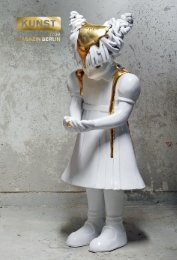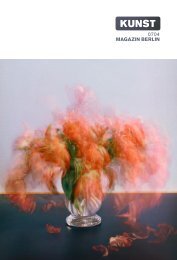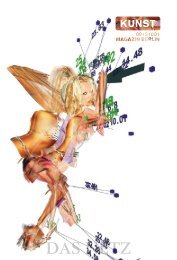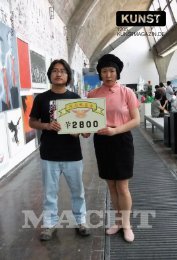KUNST für das iPad - KUNST Magazin
KUNST für das iPad - KUNST Magazin
KUNST für das iPad - KUNST Magazin
Sie wollen auch ein ePaper? Erhöhen Sie die Reichweite Ihrer Titel.
YUMPU macht aus Druck-PDFs automatisch weboptimierte ePaper, die Google liebt.
Sir Drone: A New Film About the New Beatles, Running time: 55 minutes, © 1989 Raymond Pettibon<br />
Courtesy Regen Projects, Los Angeles © Raymond Pettibon<br />
Dave Allen: Turntable performance, <strong>Magazin</strong> 4, Bregenzer Kunstverein, Foto: Werner J. Hannappe<br />
Courtesy of Elastic. Malmö<br />
The theme of the ‘backstage rider’ is approached<br />
from different angles, which overlap each other and<br />
range from the literal – i. e. the ‘classical’ backstage<br />
photography of Simon Huw Jones and Jan Windszus<br />
– to more abstract interpretations of the concept as,<br />
for instance, the myth of rock ‘n’ roll: the backstage<br />
rider is not only a part of that myth, but seems to<br />
generate myth making. Raymond Pettibon’s video<br />
“Sir Drone: A New Film About the New Beatles”<br />
(1989), which tells the story of two wannabe punk<br />
rockers, as well as Declan Clarke’s Sun Studio<br />
documentary, Dexter Dalwood’s pictured interiors of<br />
deceased stars, and Graham Dolphin’s fan memorial<br />
sculptures all in various ways deal with the myths<br />
and the image-making of the music scene.<br />
As a repetitive format, the backstage rider takes<br />
the form of a recurrent ritual or script that<br />
allows performers to stage themselves and their<br />
surroundings as in Ming Wong’s cinematic remakes<br />
and, more abstractly, John Smith’s “The Girl<br />
Chewing Gum” (1976), which dictates reality by<br />
setting word over image. The live performances of<br />
Dave Allen as well as Samuel Levack & Jennifer<br />
Lewandowski equally work from a script or score,<br />
although in very different ways.<br />
The backstage rider—not only as a score, but also<br />
as a textual format, as an encyclopedic list, and as a<br />
piece of poetry—is furthermore represented in the<br />
die Beziehung zwischen Kunst und Musik hinausgeht.<br />
Das Thema „Backstage Rider“ wird in der<br />
gleichnamigen Ausstellung des <strong>KUNST</strong> <strong>Magazin</strong>s<br />
im Tagesspiegelgebäude unter verschiedenen<br />
Gesichtspunkten betrachtet, die sich z. T.<br />
überschneiden. Ausgehend von sehr naheliegenden<br />
Interpretationen spannt sich der Bogen von der<br />
„klassischen“ Backstage Photography von Simon<br />
Huw Jones und Jan Windszus bis hin zur abstrakten<br />
Auslotung des Konzepts wie etwa im Mythos des<br />
Rock’n’Roll. Denn Backstage Rider sind nicht nur<br />
Teil dieses Mythos; sie scheinen ihn vielmehr selbst<br />
zu generieren. Raymond Pettibbons Video „Sir Drone:<br />
A New Film About the New Beatles“ (1989), <strong>das</strong><br />
die Geschichte von zwei Möchtegern-Punkrockern<br />
erzählt, Declan Clarkes Sun-Studio-Documentary,<br />
Dexter Dalwoods imaginierte Räume verstorbener<br />
Künstler sowie Graham Dolphins Denkmäler, die<br />
verschiedenen Rockhelden gewidmet sind – alle<br />
behandeln jeweils auf ihre Art die Legendenbildung<br />
in der Musikszene.<br />
Als wiederkehrendes Format thematisieren die<br />
Backstage Rider Rituale und Skripte, die es den<br />
Künstlern erlauben, sich selbst und ihre Umgebung<br />
zu inszenieren. Dies behandeln etwa Ming Wongs<br />
cineastische Remakes oder, noch abstrakter, John<br />
Smiths „The Girl Chewing Gum“ (1976): In der<br />
Überlagerung von Bild und Ton scheint sich die<br />
Realität der Stimme unterzuordnen. Die Live-<br />
Performances von Dave Allen und Samuel Levack &<br />
text pieces of Annika Ström, Alejandro Cesarco and<br />
the embroidered set lists of Rose Eken.<br />
David Medalla’s bubble machine, Vinyl-Terror<br />
& -Horror’s narrative sound sculpture and<br />
Egill Sæbjörnsson’s singing lava stones present<br />
performativity as a sculptural matter.<br />
In Tony Oursler’s video piece “EVOL” from 1984,<br />
rituals, repetition, performance anxieties and excess<br />
come together in a psychedelic low-tech theatre<br />
play about love and sex.<br />
Various aspects or abstractions of the theme of<br />
‘backstage riders’, especially a certain irony, overlap<br />
from piece to piece and tie the exhibition together in<br />
a fluid way. Moreover, the show features a ‘backstage’<br />
trivia connection: Mike Kelley, who plays one of<br />
the musicians in “Sir Drone”, also stars in “EVOL”,<br />
and he founded the band “The Poetics” together<br />
with Oursler. Sonic Youth, who also collaborated<br />
with Oursler several times and released the album<br />
“EVOL”, were equally inspired by “Sir Drone” and<br />
released the album “Goo”, which takes its title from<br />
one of the characters in the “Sir Drone” video and<br />
features Pettibon’s art work on the cover.<br />
Backstage Riders<br />
Opening: 3.9., 18h, 3.–10.9.<br />
Tagesspiegelgebäude, Haus E, 4. OG<br />
Potsdamer Str. 77-87, 10785 Berlin-Tiergarten<br />
Jennifer Lewandowski arbeiten ebenfalls mit Skripts,<br />
allerdings auf ganz unterschiedliche Weise.<br />
Nicht nur als Skript, sondern auch als enzyklopädische<br />
Liste oder Dichtung erscheinen Backstage Rider in den<br />
Textstücken von Annika Ström, Alejandro Cesarco<br />
und den bestickten Setlisten von Rose Eken.<br />
David Medallas „Bubble Machine“, Vinyl-Terror &<br />
-Horrors narrative Klangskulptur und Egill<br />
Sæbjörnssons singende Lavasteine behandeln<br />
Performativität als bildhauerisches Gestaltungsmittel.<br />
In Tony Ourslers Video „EVOL“ aus dem Jahre 1984<br />
verdichten sich Ritual, Wiederholung, Versagensangst<br />
und Exzess zu einem psychedelischen Lowtech-<br />
Theaterstück über Liebe und Sex.<br />
Die verschiedenen Aspekte zum Thema „Backstage<br />
Rider“ mit ihrem Sinn für Ironie überschneiden sich<br />
von Werk zu Werk und verschmelzen zu einer flüssigen<br />
Gesamtkomposition. Darüber hinaus wird aus dem<br />
„Backstage-Nähkästchen“ geplaudert: Mike Kelley,<br />
der einen der Musiker in dem Film „Sir Drone“ spielt,<br />
verkörperte die Hauptrolle in dem Video „EVOL“<br />
und gründete zusammen mit Oursler die Band „The<br />
Poetics Project“. Sonic Youth, die mehrmals mit<br />
Oursler zusammengearbeitet hatten und <strong>das</strong> Album<br />
„EVOL“ herausbrachten, wurden ebenfalls durch den<br />
Film „Sir Drone“ inspiriert und veröffentlichten als<br />
Ergebnis daraus <strong>das</strong> Album „Goo“: Der Titel verweist<br />
auf eine der Figuren in „Sir Drone“; Pettibon gestaltete<br />
<strong>das</strong> Albumcover.<br />
30 31


